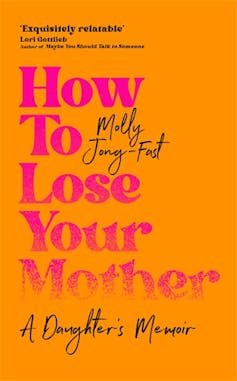Mommy dearest? Molly Jong-Fast’s blistering memoir of her ‘always performing’ mother Erica is hilarious and moving
- Written by Jane Messer, Visiting Fellow, Centre for Cultural and Creative Research, University of Canberra, University of Canberra

My first boyfriend told me with some pride that he’d read Erica Jong’s Fear of Flying (1973), and Shere Hite’s The Hite Report (1976). Though they had been selling in the millions, I hadn’t yet read either, and was keen to find out what he had learned.
He was only 16 at the time, the mid 1970s, and was a proto male feminist. He was also tender, in defiance of Erica Jong’s famous expression for spontaneous one-night-stand sex: “the zipless fuck”.
The boyfriend was a nascent sculptor and carpenter: his hobby was to collect roadkill and then painstakingly clean and reconstruct the animal’s skeleton after removing the flesh and skin. His airy bedroom accommodated possums, rats, cats, birds and a wallaby. Their skeletons shed eerie shadows across us as we lay on his bed. He was genuinely interested in how things are made.
Review: How To Lose Your Mother: A Daughter’s Memoir – Molly Jong-Fast (Picador)
This is a core question in Molly Jong-Fast’s How To Lose Your Mother, which looks back from the vantage point of what she calls “the worst year” of her life. Her mother’s physical health and dementia are worsening, Jong-Fast is juggling a high-profile job as a political commentator (at MSNBC and CNN) with parenting three children, and her husband Max faces a series of life-threatening cancers. Then, she has to move her mother and stepfather (who also has dementia) into a nursing home.
At the book’s heart, though, is the question: How did my mother Erica Jong make me, and how have I struggled to remake myself?
Her book is also very much about caring for your ageing mother – and about fame, and what happens when you’re no longer famous – written by a funny, fast-talking daughter, who is also a political writer and public intellectual in her own right. Jong-Fast loves her mother fiercely, but is horrified by the way she was raised. The memoir is hilarious, moving and educative: Don’t, whatever you do, parent like this.
Fame made Erica Jong ‘very boring’
If you’ve ever wondered what it’s like for the famous afterwards, this daughter’s portrait is almost excruciating in the ways it details the sense of loss Erica Jong lived with for years: a disfigurement even, a kind of dysmorphia. Why does the world no longer see me as I am – notorious, relevant, desirable, important?
Molly Jong-Fast watches it all:
Because she was, at the time, famous, people gave her a lot of leeway. But such allowances are a favour to no one […] Being able to get away with everything made her, in fact, very boring.
Erica Jong became famous aged 31, with the publication of the novel Fear of Flying. She gave birth to her only child Molly five years later in 1978 – then lived with declining fame for ever after. Fame encouraged Jong’s highly self-absorbed tendencies, her belief everyone – the public and her daughter – wanted to hear whatever it was she wanted to say:
Eventually, Mom would answer, but never the questions I asked. She always seemed to have a sort of stock answer […] she was always performing.
Jong published many novels and works of nonfiction over the next 30 years, and was constantly speaking and touring, but she never again achieved the impact of Fear of Flying. By the late 1990s, when Molly was close to 20 years of age and had gone AWOL on drugs and drink and was expecting to overdose any day, Jong was truly famous only among those who’d also experienced the excitement and hallelujah of the iconic second-wave feminist texts.
Fear of Flying had ranked alongside Germaine Greer’s The Female Eunuch (1970), Our Bodies, Our Selves by Boston Women’s Health Collective (1970), Kate Millet’s Sexual Politics (1970), Anne Summers’ Damned Whores and God’s Police (1975), Adrienne Rich’s Of Woman Born (1976), Doris Lessing’s To Room Nineteen: Collected Stories (1979) and Angela Carter’s The Bloody Chamber (1979).





